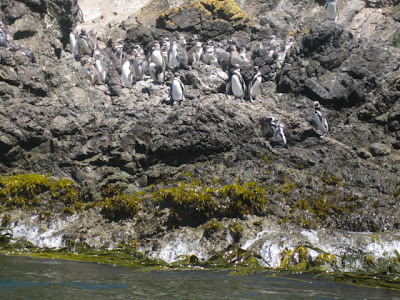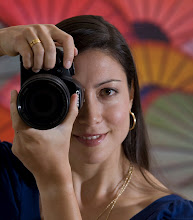For the past couple of days, I´ve been in Pucon, Chile - another popular lakeside resort with outdoor activities for both summer (rafting, kayaking, canopy tours, hiking, horseback riding, etc.) and winter (skiing, hotsprings). The big attraction in the area is Volcan Villarrica, one of Chile´s most active volcanos. In winter, people come to ski down the volcano; in summer, they come to climb up it. Because the summit climb is non-technical (no ropes required) and the volcano is easily accessible, thousands of people climb it every year. The volcano is 9340 ft (2847 m) high, and according to Wikipedia, is one of only a handful of volcanos worldwide to have an active lava lake within its crater.
We started our climb at about 8:30am in the morning, and it took us nearly six hours to get to the top. The first hour of the hike and the last 20 minutes to the summit were on volcanic rock; the rest of the hike was through snow. We were fortunate to have beautiful blue skies for most of our climb, and we were able to hike in shorts for much of the day, even far above the snow line. We were outfitted with proper mountaineering boots, heavy-duty pants/jacket, gloves, gaiters, helmet, ice axe, backpack and bum-guard for the "glissade" descent - a fancy term for sliding down the volcano on one´s backside. It wasn´t until we were hiking up the really steep snowy slopes that we put on the pants and gloves, and that was primarily in case we fell and slid down the volcano, which did happen to a couple of people in our group.
The climb was great fun, with fabulous views of not only the smoky top of the volcano, but also the surrounding mountains, lake and countryside. The clouds seemed to move so quickly up there: it could be warm and sunny one minute, then cold and grey the next. For a brief while, we were actually in a cloud and couldn´t see anything much at all!
The summit was incredible, not just for the views but for the chance to peer down into an active volcano. I didn´t know quite what to expect at the top, and it´s rather difficult to describe - take a look at the photos. Yes, it was a huge smoky abyss, but despite standing really close to the edge, I couldn´t see that far down into volcano...at least not far enough to see the active lava lake. What I found really strange was the huge amount of snow right at the top of the volcano. The snow was covered in a thin layer of lava rock, and the whole snowy-rocky mess was constantly smoking. Further inside the mouth of the volcano, the walls of rock were yellowish in color. Every few minutes, a puff of sulfur dioxide/carbon dioxide gas emerged from the volcano, which hurt to breathe and stung my eyes; nothing tops off a six-hour climb like inhaling toxic fumes. Still, it was worth it!
The descent was perhaps the most fun: we reached some pretty good speeds sliding down the volcano, and we´d use our ice axes to brake at the end of a slide. A few times we even formed chains and tobogganed down as a group. Although it took nearly six hours to climb the volcano, it took less than two hours to slide down it!
I´ve been asked to post some photos of myself, so here they are:

Volcan Villarrica in all its glory. Note the ski lifts at the base of the mountain for those who wish to bypass the rocky first hour of the hike.

Here I am about two hours into our hike...four hours still to go, and no top in sight. It was a relief to get off the scree and onto the snow.

Our first really steep snowy climb. This was the section where several people fell; if you look closely, you can see slide marks in the snow.

Clouds swirling near the top of the volcano - one minute we´d be in a cloud, the next minute it would be beautifully clear

Heading up the near-final pass
 Frances versus the volcano...too bad it´s not smoking much in this photo!
Frances versus the volcano...too bad it´s not smoking much in this photo! One view of the mouth of the volcano. What looks like dirt in the foreground is actually snow covered in a thin layer of volcanic rock. The people clustered around the rim will give you a sense of the size of the mouth.
One view of the mouth of the volcano. What looks like dirt in the foreground is actually snow covered in a thin layer of volcanic rock. The people clustered around the rim will give you a sense of the size of the mouth. Here´s the best view I could get straight into the mouth of the volcano, with its yellowish walls. The grey haze in the center of the photo is the sulfer dioxide/carbon dioxide gas (cough).
Here´s the best view I could get straight into the mouth of the volcano, with its yellowish walls. The grey haze in the center of the photo is the sulfer dioxide/carbon dioxide gas (cough). The best photo I could get of the smoky snowy-rocky surface
The best photo I could get of the smoky snowy-rocky surface Volcan Villarrica smoking gently at sunset
Volcan Villarrica smoking gently at sunset




















































